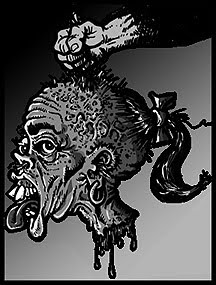Johnny Craig is one of my favorite artists from the fifties.
One of the cornerstones in the foundation of EC's dominating success in the 1950's, Johnny Craig was known for his skill as an artist (and a writer), and being a really nice guy, but also for one other unfortunate aspect. Apparently, he was a very slow and meticulous worker. In fact, listen to a few of his co-workers:
"It was hard for him to draw; it was painful watching him work. He was struggling with it all the time. He had a very exact way of working." - Wally Wood
"Al (Feldstein) was doing seven books, Johnny Craig was doing a book...Johnny was slow, so slow. Jack Davis was our fastest artist, Johnny was our slowest. He would take an entire month to write and draw one story. It was just his nature. A lot of guys in comics bat stuff out; Johnny never did. Everything had to be perfect." - William Gaines
"Johnny was extremely talented, but he had no real drive, either monetarily or from the ego point of view. He was slow in his artwork, and therefore his income was limited." - Al Feldstein
"Johnny Craig should have gotten much more recognition at EC, because his stuff was really good. In his own right, he was as good as Harvey Kurtzman, because he wrote good stories and drew them well, and knew how to entertain you." - Al Williamson
Even the author of today's tale, Archie Goodwin, had this to say: " I don't know how he made a living in comics. His work was so good, but every page took him forever."
I can't help being reminded of a quote from Ralph Waldo Emerson, who said "To be great is to be misunderstood." No one understood, but he just wanted his comics to be the best they could be, and he took great pains to bring forth his masterpieces. Clearly his pain-staking attention to details resulted in an amazing body of work that has earned him the praise and respect of comic fans everywhere. Stylistically, you can see the influences of his idols Will Eisner and Milton Caniff in his work, but Craig adds something more that is quite his own. Here is the ever-modest Craig's own take on his work output:
"I was supposed to do three stories a month. I was lucky if I did one. I was forced at an early age to learn drawing by continually searching for flaws in my own work, and then drawing it again and again to try to correct those flaws."
(By the way, those quotes and much of today's information can be found in Grant Geissman's FOUL PLAY!, a beautiful volume spotlighting all of the talented EC artists. Check it out, if you are an EC comics fan.)
When the bloody ax of Comics Code chopped the head off of the 'horror' comics boom, many publishers including EC comics died a slow and painful death, but before the last gasp (before finding a new life from MAD source), EC tried it's Picto-Fiction experiment, where Craig and his compatriots really got to show off their black and white technique. Beautiful stuff, all of it. I definitely plan to post some of those pages in the future. After that time, Craig left comics and worked in advertising, where his talents led him through the ranks straight to the top to eventually be Vice President and Art Director for a Pennsylvania based firm. Doesn't sound like someone with 'no drive' to me! It isn't surprising that one of the reasons he would leave advertising to go back into comics was because of "extreme deadline pressure"! He couldn't get away from it!
Some of the earliest work done during his 'comeback' to comics was some excellent black and white work for Warren, and today's story is a wonderful example of varying styles within one story, as you will see. Craig does it with skill. I almost said effortlessly. Now, because he was still working in advertising and he didn't want his clients to know he was doing comic book work, Craig spelled out his initials, J.T.C. -- Jay Taycee (I don't know why it isn't Jay Teecee). Whatever name he used and however long it took him, I love his work. I, for one, am grateful he took his time. Sadly, Craig passed away in 2001. We can remember him through his comics.
Read more about the great Johnny Craig here.
From
EERIE # 2, 1966, consider now today's story of a man who loves his wife
...too much. It is
hard to understand how he feels unless one looks through the...
EYE OF THE BEHOLDER!
_____________________________







































































































